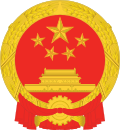
Back بلد واحد (نظامان مختلفان) Arabic Bir ölkə, iki sistem Azerbaijani Jedna země, dva systémy Czech Ein Land, zwei Systeme German Μία χώρα, δύο συστήματα Greek Un país, dos sistemas Spanish Üks riik, kaks süsteemi Estonian یک کشور، دو سیستم Persian Yksi maa, kaksi järjestelmää Finnish Un pays, deux systèmes French
This article needs additional citations for verification. (January 2022) |
| One country, two systems | |||||||||||||||||||||||
|---|---|---|---|---|---|---|---|---|---|---|---|---|---|---|---|---|---|---|---|---|---|---|---|
 Sign in Xiamen reading "一国两制统一中国" (Yīguó liǎngzhì tǒngyī Zhōngguó, transl. One country, two systems unites China) | |||||||||||||||||||||||
| Chinese name | |||||||||||||||||||||||
| Simplified Chinese | 一国两制 | ||||||||||||||||||||||
| Traditional Chinese | 一國兩制 | ||||||||||||||||||||||
| |||||||||||||||||||||||
| Portuguese name | |||||||||||||||||||||||
| Portuguese | Um país, dois sistemas[1] | ||||||||||||||||||||||
| History of the People's Republic of China |
|---|
 |
|
|
"One country, two systems" is a constitutional principle of the People's Republic of China (PRC) describing the governance of the special administrative regions of Hong Kong and Macau.
Deng Xiaoping developed the one country, two systems concept. This constitutional principle was formulated in the early 1980s during negotiations over Hong Kong between China and the United Kingdom. It provided that there would be only one China, but that each region would retain its own economic and administrative system. Under the principle, each of the two regions could continue to have its own governmental system, legal, economic and financial affairs, including trade relations with foreign countries, all of which are independent from those of the mainland. The PRC has also proposed to apply the principle in the unification it aims for with Taiwan.
- ^ Portuguese pronunciation: [ũ pɐˈiʒ ˈðojʃ siʃˈtemɐʃ]
© MMXXIII Rich X Search. We shall prevail. All rights reserved. Rich X Search